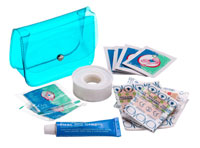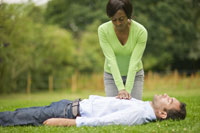- Details
- Written by: David
Need to know
- Most of us won’t have to worry about hypothermia, says the Red Cross’s Mulligan. ‘Unless you’re an extreme outdoor sports enthusiast, you’re not likely to suffer hypothermia on an outdoors trips.
- If you lose a tooth, pop it into some milk – the calcium will help keep it alive until you get to a dentist who may then be able to reattach it
- If in any doubt, call 999 – prompt action can save lives
- The Red Cross identifies the main triggers for an allergy attack as nuts, shellfish, eggs, wasp/bees, latex and medication
Assessing serious emergencies
If your are first on the scene of a serious accident, it helps to remember Dr ABC
D Assess the danger
R Check to see if there is any response
A If there is, check the airways by tilting back the head
B Listen to the breathing – if the subject can still breathe, turn them over on to their side and into the recovery position, and call the emergency services
C If there is no breathing, begin chest compressions. Place two hands in the centre of the chest and push down firmly 30 times. Then, if you are able to, give two rescue breaths (mouth-to-mouth).
How to recognise these life-threatening conditions
Stroke:
Follow the FAST approach:
F Look for facial weakness, a drooping eye or a crooked smile
A An arm weakness; perhaps they can only raise one arm, not both.
S Speech problems; they can’t speak clearly or have difficulty in understanding.
T Time to call 999.
A fast diagnosis and swift call to the emergency services is the best first aid you can do.
Continued...
 Epilepsy:
Epilepsy:
Look for visual signs such as involuntary movements, shaking, rigidity in the back, grey-blue lips.
Don’t interfere with the seizure – just try to stop the person injuring themself by moving things out of their way. Outdoors, you might cover a rock with a rolled-up coat to prevent them rolling on to it.
Do loosen tight clothing around the neck, and once the acute phase has passed, put them into the recovery position. After a seizure, sufferers can sleep for hours, so they will need keeping an eye on.
Heart attack:
Watch out for the symptoms: a central vice-like pain in the chest that may radiate up into the jaw and down into the arms. Angina is very similar, but with rest it will go away. When the pain does not go away, and is combined with breathlessness, fainting, dizziness, and a sense of impending doom, with ashen skin and the person gasping for air – it can be a heart attack.
Make the sufferer comfortable and get them into a half-sitting position with their knees up. Dial 999 and say you suspect a heart attack and why, as that will get your call prioritised. If you have an aspirin handy, get the person to crunch it – there is evidence that its blood thinning effect begins quite quickly.
Keep going
Mulligan says that many people are not keen to blow into the lungs of a stranger. If you can’t, or are unwilling to go that far, he says, keep on with the chest compressions. ‘You are not trying to bring the person back to life,’ he adds. ‘You are buying them time – keeping the blood circulating around the body to the brain, and keeping them alive – until the rescue services arrive.’
Myths – and the reality
If your child is choking, put your fingers in their mouth or hang them upside down by their feet
According to a recent Red Cross survey, this is what more than 53 per cent of parents with children under the age of eight would do. Yet placing fingers into the throat could cause vomiting or damage the child’s throat. ‘Hanging a child upside down is not an effective way to treat choking,’ says Mulligan. ‘Not only can it be very traumatic, it could also result in head injury if the child is dropped.’
Get them to try to cough up the object. If that doesn’t dislodge it, deliver five sharp blows to the back with the heel of the hand between the shoulder blades. If that hasn’t worked, try the Heimlich manoeuvre.
The best thing to put on a burn is butter
According to the survey, nearly one in five parents with young children would treat a child with a large burn by applying things such as butter, ice or margarine.
‘Putting butter or margarine on a burn is absolutely useless,’ says Joe. ‘And once the person gets to casualty, the substance will have to be removed, which could be painful.’ Nor should ice be used, as this can produce a cold burn on top of the hot burn.
Place the burn under cold running water for 10 minutes. If you don’t have access to a tap, use what you do have – a bottle of beer, for instance.
Afterwards, you need to wrap a burn in clingfilm or even a clean sandwich bag.
Continued...
 To treat a nosebleed you should tilt the victim’s ?head back and pinch their nose
To treat a nosebleed you should tilt the victim’s ?head back and pinch their nose
Tilting the head back will encourage the blood to run down the back of the throat and possibly into the stomach, inducing vomiting. Some people also say you should place a cold object on the base of the neck but this is an old wives’ tale.
Tilt the head forward and pinch the soft part of the nose for up to 10 minutes, or until the bleeding stops. Then clean around the nose with lukewarm water.
You must remove an object embedded in a wound ?as soon as possible
The object in the wound could be blocking further blood loss, so if you pull it out you could be dealing with a major haemorrhage.
Raise the injury above the level of the heart and press firmly on either side of the object to push the edges of the wound together. Treat for shock – monitor and record vital signs while waiting for help to arrive.
When you give someone the kiss of life, you should see immediate results
People rarely respond immediately to CPR. But this does not mean you are not helping to save their life. Your efforst may be crucial. ‘The first few minutes are critical. CPR helps to keep the key organs alive until the ambulance arrives, so you should not give up,’ says Mulligan.
Resuscitation can go on for hours; once you start, you need to keep going. If you get tired, ask someone else to take over and keep going until the ambulance arrives.




